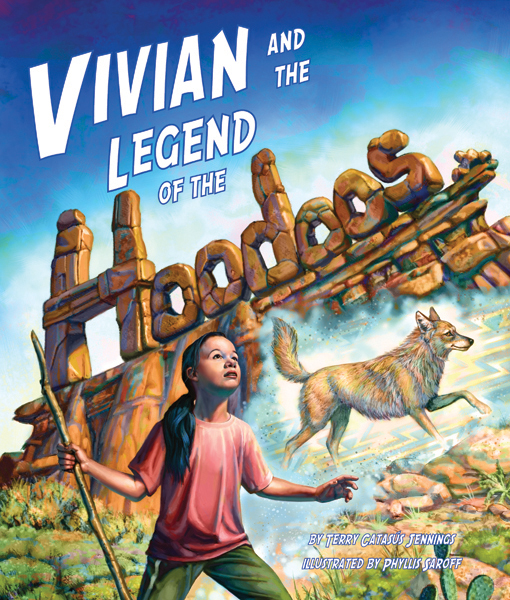Terry Catasús Jennings
News and Reviews!!!
KIRKUS REVIEW
Paiute protagonist Vivian tries to find a way to connect her people’s traditions with the modern world.
No longer a little girl, preteen Vivian questions Grandma’s insistence on gathering pine nuts in the time-consuming traditional way. Basketball try-outs will start in three hours, and she hopes to make the team. Besides, Vivian already knows the story of how Sinawav the coyote punished the Old Ones for their greed by changing them into rocky hoodoos. From science class, she also knows that erosion has formed the stone columns. Grandma understands the science too, but she still insists they gather in the traditional Paiute way. When Vivian practices basketball shots with the pine cones, Grandma turns this lack of respect into a learning opportunity. She leads Vivian to the site of an ancestral village and shows her a pottery sherd, a bone awl, and obsidian chips, and explains how they were used. Through this experience, Vivian gains a deeper understanding of how their Paiute ancestors respected the interdependence of all creatures. Jennings’ carefully crafted text weaves a lyrical story that blends the present with the rich heritage of the Paiute culture. She also includes comprehensive backmatter that offers parents and teachers historical and scientific facts. Saroff’s luminous use of color and her attention to details complement the story, though her photorealistic humans sometimes appear rather stiff.
A story that honors both tradition and its young protagonist’s desire to live in the present. (bibliography) (Picture book. 4-9)
By Sarah Corsa Las Vegas Review-Journal
May 6, 2017 - 5:25 pm
As a science writer, often of children’s books, Terry Jennings has a thing for erosion. But she wagered she wouldn’t have an easy time getting kids excited about the force responsible for many of the rock formations in Southern Nevada, Utah and Arizona.
“(It) can be a destructive force, but also a force that creates beautiful things,” Jennings said.
After reading about the Paiute legend of the hoodoos on a trip to Bryce Canyon National Park in Utah, she knew she had the hook that would make the topic interesting and relevant to children. Hoodoos are the tall, thin rock formations that Bryce Canyon is known for.
Jennings released the book, “Vivian and the Legend of the Hoodoos” (Arbordale Publishing, $17.95), in February. Vivian goes with her grandmother to pick pine nuts on the mesa. When the young girl, impatient for her basketball tryouts later that day, begins showing disrespect to the trees they’re picking the nuts from, her grandmother explains the significance of the traditional Paiute practices to Vivian. The final pages explain the natural process that results in the rock towers.
Jennings, who lives in St. George, Utah, from January through April and the rest of the year in Reston, Virginia, wrote the book in consultation with members of the Shivwits Band of Paiute Indians, who live in the southwest corner of Utah near St. George.
Glenn Rogers, a Shivwits council member whom Jennings worked with on the book, appreciates that she reached out to the tribe to verify the details of the Paiute culture, because many writers before her had not. “People bring out books and they assume what this means and they assume what that means,” Rogers said.
In Jennings’ research, she confirms facts about the legend itself, the details of the Paiute’s pine nut collection and the relationship between grandmother and granddaughter. “I wanted to make sure that anything that I said was met with their approval. It was actually a good thing that I wanted to do that because they made my story so much richer,” Jennings said.
One facet of Paiute culture that Rogers emphasized in his conversations with Jennings was the meaning of the word “hoodoo.” In the Paiute language, it refers to more than just the rock formations. “Hoodoo” can be used to refer to the unknown, another being or spirit, or a place that you can hide behind. It can also be an expression of fear. In the book, Vivian’s grandmother used the term to scare her into obeying.
Jennings relies on her own background coming to the U.S. from Cuba at 12 years old to depict universal experiences of being a kid in a story that both Paiute and non-Paiute children can understand.
“I want kids to identify with the fact that whether you’re Native American, whether you’re Cuban, whether you’re Pakistani or Lebanese, whatever, Chinese, you are a human being and all these kids are wanting to do the same things,” Jennings said.
SCHOOL LIBRARY JOURNAL - AUGUST 2017
Gr 1-3–Vivian and her grandmother are harvesting pine nuts as they have every year, but this year Vivian is impatient. Basketball tryouts are in a few hours, and to save time, she begins to throw the cones carelessly into her bucket instead of asking the trees for their permission to be picked. Vivian is reminded of the legend of the hoodoos, the tall rock columns who had been bad and turned to rock as a result. Vivian’s grandmother reminds her of the many ways the land has helped them and their ancestors, and of why they should always respect their environment. An informative section on Paiute culture and history, weathering and erosion, and hoodoos is included. Beautiful illustrations and clear text make this accessible to young readers. VERDICT Recommended for most picture book collections.–Selenia Paz, Helen Hall Library, League City, TX
